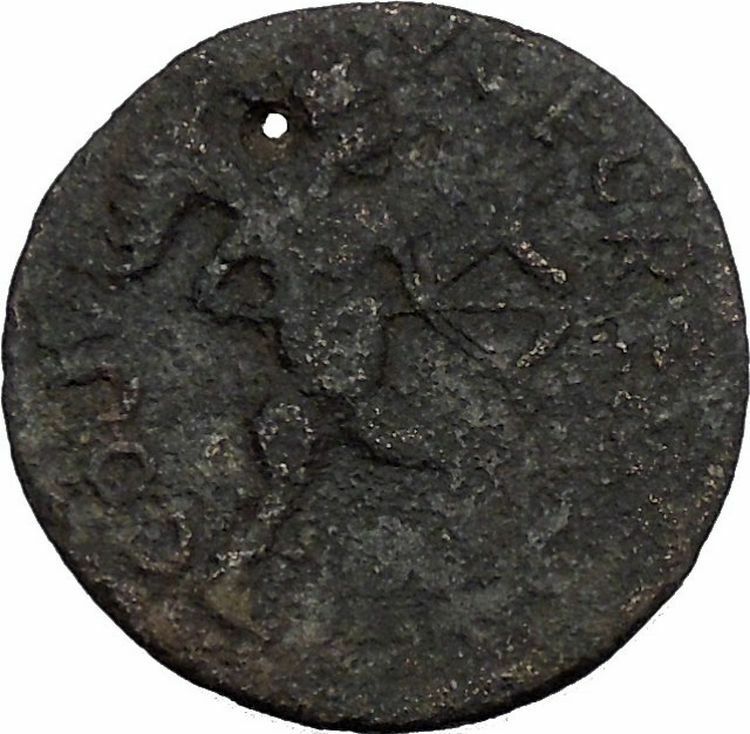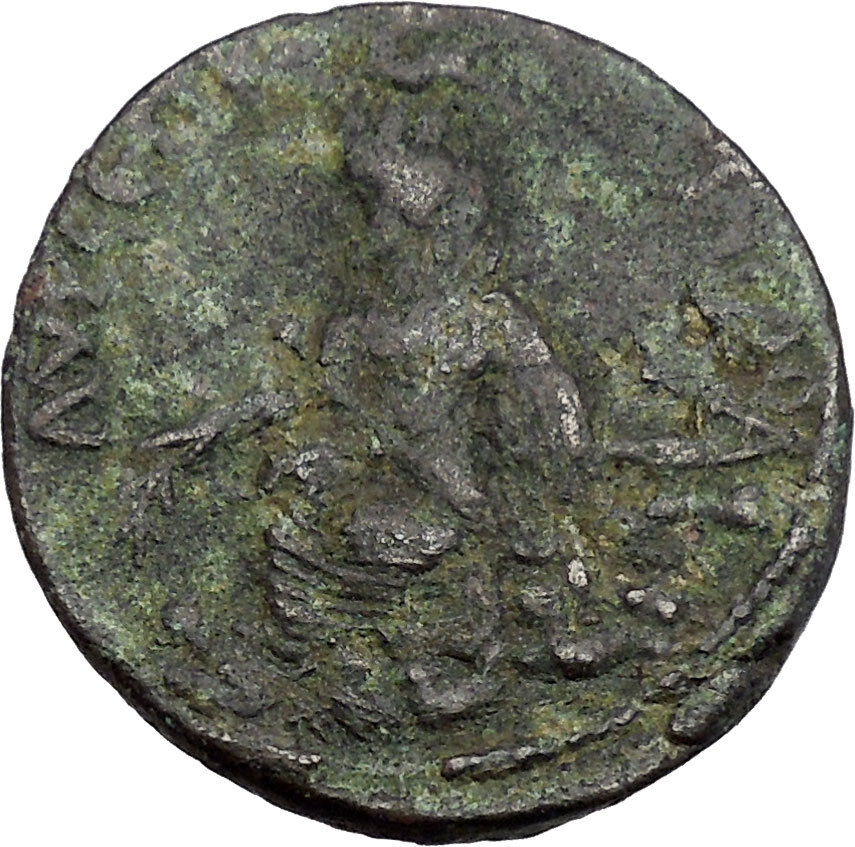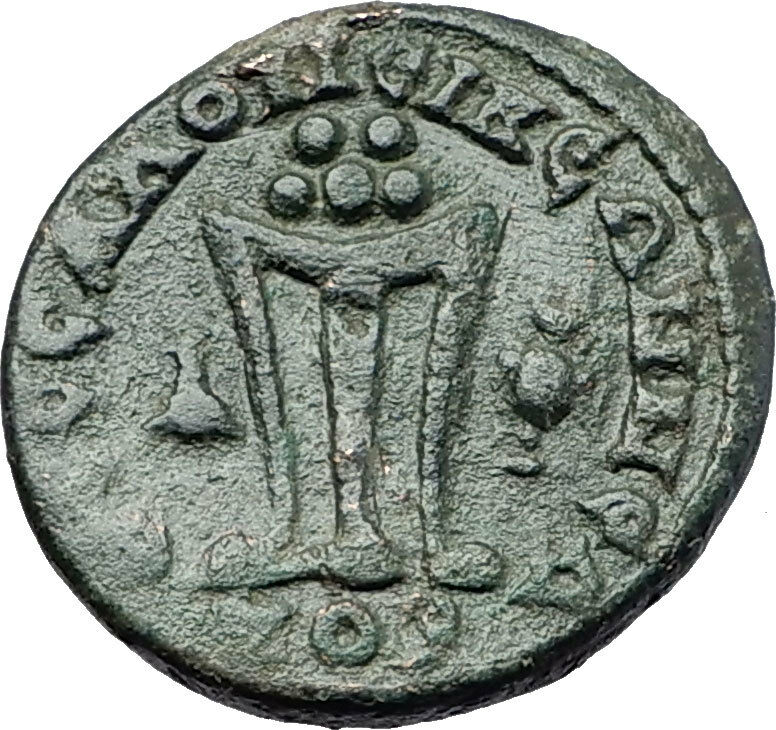|
Septimius Severus – Roman Emperor: 193-211 A.D. –
Bronze 15mm (1.97 grams) of
Nicaea
in
Bithynia
Reference: RG 440; Weiser –; SNG Copenhagen –; SNG von Aulock 582
AV KA CЄΠT CЄVHPOC, Laureate head right.
NIKAIЄΩN, Serpent peering out of a half-open cista mystica.
You are bidding on the exact item pictured,
provided with a Certificate of Authenticity and Lifetime Guarantee of
Authenticity.
In the
Mystery cult
, a cista mystica (literally
“sacred chest”) is a basket or chest used to house snakes. Cistae mysticae were
used in the initiation ceremony of the cult of Bacchus, or
Dionysus,
as well as an early
gnostic
sect called the
Ophites.
Cistae mysticae appear on ancient Roman and Greek coins.
A cista (kiste) in the classical world was generally a casket, used
for example to hold unguents or jewels. More specifically, in the
Mystery cult
, a cista mystica (literally
“sacred chest”) is a basket or chest used to house snakes. Cistae mystica were
used in the initiation ceremony of the cult of Bacchus or
Dionysus
, as well as an early
gnostic
sect called the
Ophites
. Cistae mysticae appear on ancient
Roman and Greek coins.
Furthermore small Cistas were worked in Etruria, contained in cylindrical
bronze containers for domestic use and storage of toiletries. Their faces were
usually adorned engraved with figures, soldered on the top small bronze figures.
The Cista could be realised with different materials like wicker, wood,
rawhide, but above of all in metal, used from the 5th century. The Etruscans
manufactured it in different qualities from the 5th century, at first in ovoid
form with thrown scenes, and then in cylindrical form with engraved scenes. The
handle of the lid was consisted by little structures. One of the most important
city of production of Cista is Preneste, an old city of Lazio, which realised
different types of Cista from the 4th century.
The place is said to have been colonized by
Bottiaeans
, and to have originally borne the
name of Ancore (Steph.
B. s. v.) or Helicore (Geogr. Min. p. 40, ed. Hudson); but it
was subsequently destroyed by the
Mysians
. A few years after the death of
Alexander the Great
,
Macedonian
king
Antigonus
— who had taken control of much of
Asia Minor
upon the death of Alexander (under
whom Antigonus had served as a general) — probably after his victory over
Eumenes
, in 316 BC, rebuilt the town, and
called it, after himself, Antigoneia (Greek:
Αντιγόνεια). (Steph. B. l. c.; Eustath. ad
Horn. II. ii. 863) Several other of Alexander’s generals (known together as the
Diadochi
(Latin; original Greek
DiadokhoiΔιάδοχοι/
“successors”)) later conspired to remove Antigonus, and after defeating him the
area was given to
Thessalian
general
Lysimachus
(Lysimakhos) (circa 355
BC-281 BC) in 301 BC as his share of the lands. He renamed it Nicaea
(Greek:
Νίκαια
, also
transliterated
as Nikaia or Nicæa;
see also
List of traditional Greek place names
), in
tribute to his wife Nicaea, a daughter of
Antipater
. (Steph. B., Eustath., Strab., ll.
cc.) According to another account (Memnon, ap. Phot. Cod. 224. p. 233, ed.
Bekker), Nicaea was founded by men from
Nicaea
near
Thermopylae
, who had served in the army of
Alexander the Great. The town was built with great regularity, in the form of a
square, measuring 16 stadia in circumference; it had four gates, and all its
streets intersected one another at right angles, so that from a monument in the
centre all the four gates could be seen. (Strabo
xii. pp. 565 et seq.) This monument stood in the gymnasium, which was
destroyed by fire, but was restored with increased magnificence by the
younger Pliny
(Epist. x. 48), when he was
governor of Bithynia
.
The city was built on an important crossroads between
Galatia
and
Phrygia
, and thus saw steady trade. Soon after
the time of Lysimachus, Nicaea became a city of great importance, and the kings
of Bithynia, whose era begins in 288 BC with
Zipoetes
, often resided at Nicaea. It has
already been mentioned that in the time of Strabo it is called the metropolis of
Bithynia, an honour which is also assigned to it on some coins, though in later
times it was enjoyed by
Nicomedia
. The two cities, in fact, kept up a
long and vehement dispute about the precedence, and the 38th oration of
Dio Chrysostomus
was expressly composed to
settle the dispute. From this oration, it appears that Nicomedia alone had a
right to the title of metropolis, but both were the first cities of the country.
The younger Pliny makes frequent mention of Nicaea and its public buildings,
which he undertook to restore when governor of Bithynia. (Epist. x. 40, 48,
etc.) It was the birthplace of the astronomer
Hipparchus
(ca. 194 BC), the mathematician and
astronomer
Sporus
(ca. 240) and the historian
Dio Cassius
(ca. 165). It was the death-place
of the comedian
Philistion
. The numerous coins of Nicaea which
still exist attest the interest taken in the city by the emperors, as well as
its attachment to the rulers; many of them commemorate great festivals
celebrated there in honour of gods and emperors, as Olympia, Isthmia, Dionysia,
Pythia, Commodia, Severia, Philadelphia, etc. Throughout the imperial period,
Nicaea remained an important town; for its situation was particularly
favourable, being only 40 km (25 mi) distant from
Prusa
(Pliny
v. 32), and 70 km (43 mi) from
Constantinople
. (It.
Ant. p. 141.) When Constantinople became the capital of the
Eastern Empire
, Nicaea did not lose in
importance; for its present walls, which were erected during the last period of
the Empire, enclose a much greater space than that ascribed to the place in the
time of Strabo. Much of the existing architecture and defensive works date to
this time, early 300s.
Nicaea suffered much from earthquakes in 358, 362 and 368; after the last of
which, it was restored by the emperor
Valens
. During the Middle Ages it was for a
long time a strong bulwark of the
Byzantine
emperors against the
Turks
.
Nicaea
in early Christianity
See also:
First Council of Nicaea
and
Second Council of Nicaea
In the reign of
Constantine
, 325, the celebrated
First Council of Nicaea
was held there against
the Arian
heresy
, and the prelates there defined more
clearly the concept of the
Trinity
and drew up the
Nicene Creed
. The
doctrine
of the Trinity was finalized at the
Council of Constantinople in 381 AD which expressly included the Holy Ghost as
equal to the Father and the Son. The first Nicene Council was probably held in
what would become the now ruined mosque of Orchan. The church of Hagia Sophia
was built by
Justinian I
in the middle of the city in the
6th century (modelled after the larger
Hagia Sophia
in Constantinople), and it was
there that the
Second Council of Nicaea
met in 787 to discuss
the issues of
iconography
.
L ucius Septimius Severus (or rarely Severus I) (April 11, ucius Septimius Severus (or rarely Severus I) (April 11,
145/146-February 4, 211) was a
Roman
general, and
Roman
Emperor
from April 14, 193 to 211. He was born in what is now the
Berber
part of
Rome’s historic
Africa Province
.
Septimius Severus was born and raised at
Leptis
Magna
(modern Berber
, southeast of
Carthage
,
modern Tunisia
).
Severus came from a wealthy, distinguished family of
equestrian
rank. Severus was of
Italian
Roman ancestry on his mother’s side and of
Punic
or
Libyan
-Punic
ancestry on his father’s. Little is known of his father,
Publius Septimius Geta
, who held no major political status but had two
cousins who served as consuls under emperor
Antoninus Pius
. His mother, Fulvia Pia’s family moved from
Italy
to
North
Africa
and was of the
Fulvius
gens,
an ancient and politically influential clan, which was originally of
plebeian
status. His siblings were a younger
Publius Septimius Geta
and Septimia Octavilla. Severus’s maternal cousin was
Praetorian Guard
and consul
Gaius Fulvius Plautianus
.
In 172, Severus was made a
Senator
by the then emperor
Marcus Aurelius
. In 187 he married secondly
Julia
Domna
. In 190 Severus became
consul
, and in
the following year received from the emperor
Commodus
(successor to Marcus Aurelius) the command of the
legions
in Pannonia
.
On the murder of
Pertinax
by
the troops in 193, they proclaimed Severus Emperor at
Carnuntum
,
whereupon he hurried to Italy. The former emperor,
Didius Julianus
, was condemned to death by the Senate and killed, and
Severus took possession of Rome without opposition.
The legions of
Syria
, however, had proclaimed
Pescennius Niger
emperor. At the same time, Severus felt it was reasonable
to offer
Clodius Albinus
, the powerful governor of Britannia who had probably
supported Didius against him, the rank of Caesar, which implied some claim to
succession. With his rearguard safe, he moved to the East and crushed Niger’s
forces at the
Battle of Issus
. The following year was devoted to suppressing Mesopotamia
and other Parthian vassals who had backed Niger. When afterwards Severus
declared openly his son
Caracalla
as successor, Albinus was hailed emperor by his troops and moved to Gallia.
Severus, after a short stay in Rome, moved northwards to meet him. On
February
19
, 197
,
in the
Battle of Lugdunum
, with an army of 100,000 men, mostly composed of
Illyrian
,
Moesian
and
Dacian
legions,
Severus defeated and killed Clodius Albinus, securing his full control over the
Empire.
Emperor
Severus was at heart a
soldier
, and
sought glory through military exploits. In 197 he waged a brief and successful
war against the
Parthian Empire
in retaliation for the support given to Pescennius Niger.
The Parthian capital
Ctesiphon
was sacked by the legions, and the northern half of
Mesopotamia
was restored to Rome.
His relations with the
Roman
Senate
were never good. He was unpopular with them from the outset, having
seized power with the help of the military, and he returned the sentiment.
Severus ordered the execution of dozens of Senators on charges of corruption and
conspiracy
against him, replacing them with his own favorites.
He also disbanded the
Praetorian Guard
and replaced it with one of his own, made up of 50,000
loyal soldiers mainly camped at
Albanum
, near Rome (also probably to grant the emperor a kind of centralized
reserve). During his reign the number of legions was also increased from 25/30
to 33. He also increased the number of auxiliary corps (numerii), many of
these troops coming from the Eastern borders. Additionally the annual wage for a
soldier was raised from 300 to 500
denarii
.
Although his actions turned Rome into a military
dictatorship
, he was popular with the citizens of Rome, having stamped out
the rampant corruption of Commodus’s reign. When he returned from his victory
over the Parthians, he erected the
Arch of Septimius Severus
in Rome.
According to Cassius Dio,
however, after 197 Severus fell heavily under the influence of his Praetorian
Prefect,
Gaius Fulvius Plautianus
, who came to have almost total control of most
branches of the imperial administration. Plautianus’s daughter,
Fulvia Plautilla
, was married to Severus’s son, Caracalla. Plautianus’s
excessive power came to an end in 205, when he was denounced by the Emperor’s
dying brother and killed.
The two following praefecti, including the jurist
Aemilius Papinianus
, received however even larger powers.
Campaigns in Caledonia (Scotland)
Starting from 208 Severus undertook a number of military actions in
Roman
Britain
, reconstructing
Hadrian’s Wall
and campaigning in
Scotland
.
He reached the area of the
Moray
Firth
in his last campaign in Caledonia, as was called Scotland by
the Romans..
In 210 obtained a peace with the
Picts
that lasted
practically until the final withdrawal of the Roman legions from Britain,
before falling severely ill in
Eboracum
(York).
Death
He is famously said to have given the advice to his sons: “Be harmonious,
enrich the soldiers, and scorn all other men” before he died at Eboracum on
February 4
,
211. Upon his death in 211, Severus was
deified
by the Senate and succeeded by his sons,
Caracalla
and
Geta
, who were advised by his wife
Julia
Domna
. The stability Severus provided the Empire was soon gone under their reign.
Accomplishments and Record
Though his military expenditure was costly to the empire, Severus was the
strong, able ruler that Rome needed at the time. He began a tradition of
effective emperors elevated solely by the military. His policy of an expanded
and better-rewarded army was criticized by his contemporary
Dio Cassius
and
Herodianus
: in particular, they pointed out the increasing burden (in the
form of taxes and services) the civilian population had to bear to maintain the
new army.
Severus was also distinguished for his buildings. Apart from the triumphal
arch in the Roman Forum carrying his full name, he also built the
Septizodium
in Rome and enriched greatly his native city of
Leptis
Magna
(including another triumphal arch on the occasion of his visit of
203).
Severus and Christianity
Christians were
persecuted
during the reign of Septimus Severus. Severus allowed the
enforcement of policies already long-established, which meant that Roman
authorities did not intentionally seek out Christians, but when people were
accused of being Christians they could either curse
Jesus
and make an
offering to
Roman gods
, or be executed. Furthermore, wishing to strengthen the peace by
encouraging religious harmony through
syncretism
,
Severus tried to limit the spread of the two quarrelsome groups who refused to
yield to syncretism by outlawing
conversion
to Christianity or
Judaism
.
Individual officials availed themselves of the laws to proceed with rigor
against the Christians. Naturally the emperor, with his strict conception of
law, did not hinder such partial persecution, which took place in
Egypt
and the
Thebaid
, as
well as in
Africa proconsularis
and the East. Christian
martyrs
were
numerous in Alexandria
(cf.
Clement of Alexandria
, Stromata, ii. 20;
Eusebius
, Church History, V., xxvi., VI., i.). No less severe were
the persecutions in Africa, which seem to have begun in 197 or 198 (cf.
Tertullian’s
Ad martyres), and included the Christians known in the
Roman martyrology
as the martyrs of
Madaura
.
Probably in 202 or 203
Felicitas
and
Perpetua
suffered for their faith. Persecution again raged for a short time
under the proconsul
Scapula
in
211, especially in
Numidia
and
Mauritania
.
Later accounts of a Gallic
persecution, especially at
Lyon, are
legendary. In general it may thus be said that the position of the Christians
under Septimius Severus was the same as under the
Antonines
;
but the law of this Emperor at least shows clearly that the
rescript
of
Trajan
[
neededclarification] had failed to execute its purpose.
|





 ucius Septimius Severus (or rarely Severus I) (April 11,
ucius Septimius Severus (or rarely Severus I) (April 11, 


